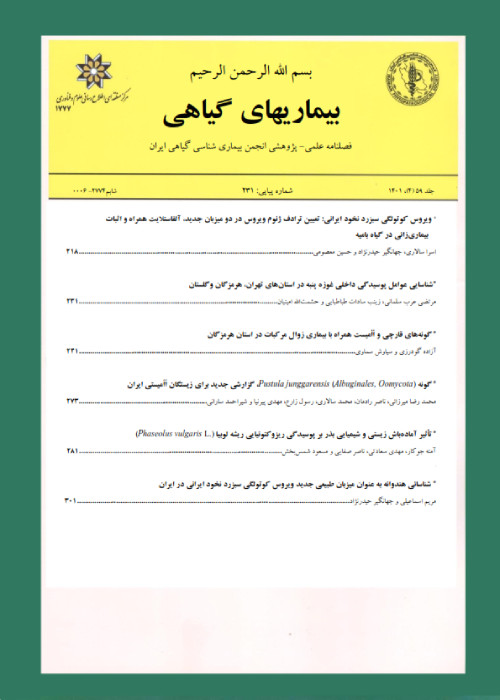REACTION OF PISTACHIO CULTIVARS TO Phytophthora pistaciae AND THE INFLUENCE OF TEMPERATURE ON ITS PATHOGENICITY
Abstract:
Pistachio gummosis is the most important disease of pistachio trees in Iran. The fungus-like oomycetous pathogen، Phytophthora pistaciae، is a major cause of the disease. In order to investigate the reaction of different pistachio cultivars، P. pistaciae was isolated from infected pistachio trees in Yazd and Kerman Provinces of Iran during 2009 and 2010. These isolates were identified based on morphological and ribosomal genome characteristics، and their pathogenicity confirmed. In this study، five-month-old seedlings of various pistachio cultivars including Sarakhs، Badami-Rize-Zarand، Ghazvini، Kaleh Ghochi، Ahmad Aghaiy، Ohadi، Khanjari-Damghan، and Fandoghi were challenge inoculated using different isolates of P. pistaciae. The disease symptoms in infected cultivars were monitored for six months and the percentage of dead trees، the fresh and dry weight of roots and shoots، height of the plants and percentage of the root colonization were determined. The trial was performed as a two-factor factorial experiment with 3 replications for each combination، the factors being cultivars and isolates at 7 and 3 levels، respectively، in a completely randomized design. No significant differences were observed among pathogenicity of the pathogen isolates. A comparison of mortality showed that the Sarakhs had the highest percentage of deaths (80%) and the Badami-Rize-Zarand had the lowest percentage of deaths (15%)، while in Ghazvini no mortality was observed. The results of root colonization by pathogen varied in various cultivars، with the Sarakhs and Ghazvini giving the maximum and minimum root colonization، respectively. Sarakhs had the most height reduction (45%)، with the Badami-Rize-Zarand (12%) and Ghazvini (8%) cultivars having the least. Studies on fresh and dry weight of shoots and roots of plants also showed some reduction in infected plant tissues، with the Sarakhs cultivar having the highest weight reduction in comparison with the control. On the whole، using the investigated criteria، Ghazvini and Badami-Rize-Zarand seemed to be more resistant than other cultivars، with Sarakhs being the most susceptible one. Although 30 °C was calculated as the optimal temperature for pathogenicity in Sarakhs cultivar، the results showed that the range of 25 to 30 °C could be extensively effective in development of the disease.
Keywords:
Language:
Persian
Published:
Iranian Journal of Plant Pathology, Volume:49 Issue: 3, 2013
Page:
279
magiran.com/p1213499
دانلود و مطالعه متن این مقاله با یکی از روشهای زیر امکان پذیر است:
اشتراک شخصی
با عضویت و پرداخت آنلاین حق اشتراک یکساله به مبلغ 1,390,000ريال میتوانید 70 عنوان مطلب دانلود کنید!
اشتراک سازمانی
به کتابخانه دانشگاه یا محل کار خود پیشنهاد کنید تا اشتراک سازمانی این پایگاه را برای دسترسی نامحدود همه کاربران به متن مطالب تهیه نمایند!
توجه!
- حق عضویت دریافتی صرف حمایت از نشریات عضو و نگهداری، تکمیل و توسعه مگیران میشود.
- پرداخت حق اشتراک و دانلود مقالات اجازه بازنشر آن در سایر رسانههای چاپی و دیجیتال را به کاربر نمیدهد.
In order to view content subscription is required
Personal subscription
Subscribe magiran.com for 70 € euros via PayPal and download 70 articles during a year.
Organization subscription
Please contact us to subscribe your university or library for unlimited access!


